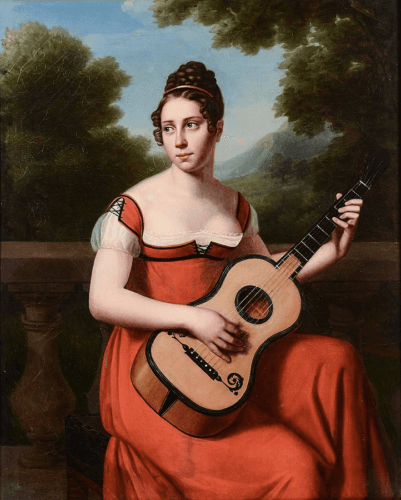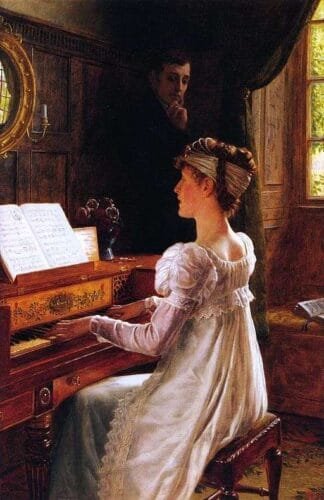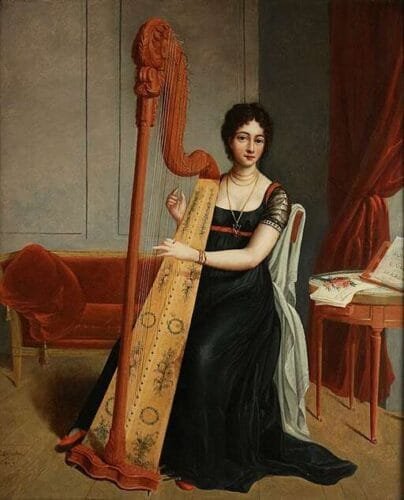Regency Girls’ Education–What did They Need to Know pt 2

With all the emphasis on young gentlemen’s education, it is easy to overlook the education of girls during the Regency Era. Women, even upper-class woman, were not simply decorative bits of fluff. Even if ‘only’ destined for marriage, there were responsibilities and competencies they would be expected to fulfill in their daily lives.
Many of these skills were not easily displayed, and thus not useful in the ever-important task of attracting the attention of the right sort of gentleman. So, her education also emphasized accomplishments which enabled her to display cultural distinction and set herself apart from women who were merely ‘notable’—those who could only manage a household but not elegant. These included skills in performing arts such as singing, playing an instrument and dancing, as well as decorative arts like drawing, painting and needlework.
The skills that we often associate with running a house: cooking, cleaning, laundry and the like, were the tasks of servants. A gentry or upper-class mother might teach her daughter about those tasks so she could supervise the servants, but not to actually do the tasks herself.
Practical skills girls needed to know
Music

Though not expected to be virtuosos, quality young ladies were expected to be proficient musicians. Playing and singing were considered seductive to men since they displayed her body and bearing to potential suitors. Furthermore, once married, musical skills would be useful for long evenings of entertaining both her husband and her guests.

Only a few instruments were considered appropriate for young ladies, though. Anything which needed to be blown into was a risk for causing a reddened face and heaving bosom, neither of which would be attractive, much less alluring, so they were out of the question. (There goes the hopes and dreams of all the young ladies interested in playing trombone and tuba.)
The violin, which required raised arms, was also inappropriate, for very practical reasons. The short-bodied dresses of the era presented too many possibilities for embarrassing mishaps. Moreover, while one could fudge and slur their way through a piano piece, the violin was not an instrument for amateurs.

The harp was the most desirable instrument, displaying the grace and beauty of the feminine form while playing. But it was very expensive and out of reach of most families. So, most had to make do with the piano which had replaced the harpsichord in popularity. Some young ladies also learned the guitar or mandolin.
Dance
Not only did girls need to be able to play and sing, but they had to be able to dance. The dance floor was the place for young ladies to interact with their suitors, a place where they could escape the watchful eyes of their chaperones and engage in somewhat private conversation and even touch, which was otherwise forbidden. Skilled and graceful partners were highly desirable. Dancing well together was believe to be a mark of mutual suitability for a couple. Girls who danced poorly could expect to spend a lot of time without a partner.


British Museum, Public domain, via Wikimedia Commons© The Trustees of the British Museum, released as CC BY-NC-SA 4.0

Partnered dances like the minuet or the waltz were not popular during the Regency. Most dancing would have been done in sets of couples, some in long lines, others in square sets, and still others in circles. In some cases, the name of the dance would be announced, and those who knew the dance would join the set. In others, the lady in first (top) couple of the set would choose the music and the steps that would go with that music. She and her partner would demonstrate the steps, then dance with each of the couples in turn, potentially making for a very long dance set.
Good manners suggested that this lady be sensitive to the group, and if less experienced dancers were taking part, make sure she select simpler steps. (We can all imagine how this might have gone terribly wrong, can’t we?)
In either case, dancers needed to know the basics steps, and often the entire choreography of a dance. Dance masters would be hired to teach those steps to both young ladies and young gentlemen. New dances would be released each year, ensuring that dance masters would always have something new to each their pupils.
Artistic Endeavors

Girls were encouraged to draw and paint and given training in it whenever possible. Particularly talented girls might even exhibit their work at local or national levels, or teach other girls, all of which could be valuable if she failed to obtain a husband.
Filigree work, now known as quilling, and japanning, now called decoupage, were also encouraged as ways for ladies to display their artistic skills. Screens, small chests and trunks and various bric-a-brac were frequently the object of their efforts.
In addition to showing off the status of her family to have been able to give her these skills, a woman’s art work also demonstrated the leisure time in which she pursued it. Having time for the projects, and the disposable income for the supplies and equipment required, and the ancillaries like mounting and framing pieces, all were subtle displaces of wealth and status that could be tastefully displayed for the admiration of her guests.
Needlework

Needlework was one of the most practical subjects for a young lady to learn. No matter what her future might hold, clothing, plain or elegant, would be a part of it. Clothing required mending and making. Even ladies who could hire out their own sewing would often engage in making garments for charitable cases in their parish. Fancy work included embroidery, cross stitch, knotting, netting and more.
Typically, a girl would make four samplers in her needlework curriculum. (Yes, this was one of the rare places where there was a more or less established course of study.) First, she would make a marking sampler, at the age of five or six. The marking sampler taught a little girl her letters which she would use to mark laundry. This skill was essential for all girls, rich or poor.
Major aside here regarding laundry: During the Regency Era, laundry was not a weekly affair. It took resources and a great deal of (wo)man power to accomplish. On larger estates, charwomen, often with the assistance of household maids, would come in monthly to do the laundry. Outer garments like dresses, coats and pants would be the smallest part of the laundry load. Body linen, worn under most garments to protect them from sweat and body oils, and household linen, bed linen, towels, tablecloths, napkins, and the like made up the bulk of the laundry.
Linens would be marked with initials and numbers to identify them. These marks would also help in the orderly rotation of household linens to ensure even wear among them. In smaller households where the laundry was sent out, these marks would also help ensure the laundry got back to the correct house.
At the age of eight to ten, a girl would begin practicing her fancy embroidery and produce a second, much more decorative sampler. In another few years, she would produce a sampler of mixed colored and white work. these decorative pieces could incorporate other parts of her education. Sometimes maps and globes were embroidered.
Finally, she would create a full white work sampler. This collection of four pieces could later serve as reference for future decorative projects.



Needlework need not be a solitary endeavor. Often, women would bring along their work baskets during social calls and work as they visited. If someone arrived without something to work on, a hostess might offer something from her workbasket. Usually, women brought fancy embroidery to work on during social calls, reserving mundane sewing and mending for home—I mean, really, who wants to be patching small clothes with her friends watching?
Where did a girl learn all these practical skills? We’ll talk about that next time.
So, what do you think of this aspect of a girl’s education? Was it what you were expecting? Tell me in the comments.
Click here to read more about Regency Era education
Click here to read more about accomplishments in the Regency Era.
Click here to read more about Ladies in the Regency Era.
Click here to go to the Regency Index.
References
Baird, Rosemary. Mistress of the House, Great Ladies and Grand Houses. Phoenix (2003)
Collins, Irene . Jane Austen, The Parson’s Daughter Hambledon (1998)
Collins, Irene . Jane Austen & the Clergy The Hambledon Press (2002)
Davidoff, Leonore & Hall, Catherine. Family Fortunes: Men and Women of the English Middle Class 1780-1850 Routledge (2002)
The Female Preceptor. Essays On The Duties Of The Female Sex, Conducted By A Lady. 1813 and 1814
Fullerton, Susannah. Jane Austen & Crime JASA Press (2004)
Harvey, A. D. Sex in Georgian England Phoenix Press (1994)
Ives, Susanna Educating Your Daughters – A Guide to English Boarding Schools in 1814, March, 10 2013.
Jones, Hazel. Jane Austen & Marriage Continuum Books (2009)
Lane, Maggie. Jane Austen’s World Carlton Books (2005)
Laudermilk, Sharon & Hamlin, Teresa L. The Regency Companion Garland Publishing (1989)
Le Faye, Deirdre. Jane Austen: The World of Her Novels Harry N. Abrams (2002)
Martin, Joanna. Wives and Daughters Hambledon Continuum (2004)
Murden, Sarah. Education, Education , Education—for Girls in the Georgian Era. All things Georgian. November 21, 2022. Accessed June 27, 2024. ttps://georgianera.wordpress.com/2022/11/21/education-education-education-for-girls-in-the-georgian-era/
Selwyn, David. Jane Austen & Leisure The Hambledon Press (1999)
Sullivan, Margaret C. The Jane Austen Handbook Quirk Books (2007)
Watkins, Susan. Jane Austen’s Town and Country Style Rizzoli (1990)
Vickery, Amanda. The Gentleman’s Daughter. Yale University Press (1998)

Comments
Regency Girls’ Education–What did They Need to Know pt 2 — No Comments
HTML tags allowed in your comment: <a href="" title=""> <abbr title=""> <acronym title=""> <b> <blockquote cite=""> <cite> <code> <del datetime=""> <em> <i> <q cite=""> <s> <strike> <strong>